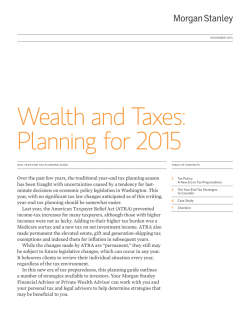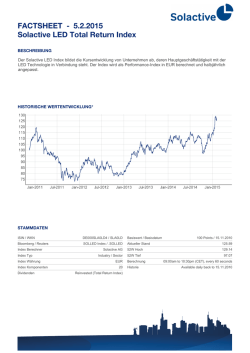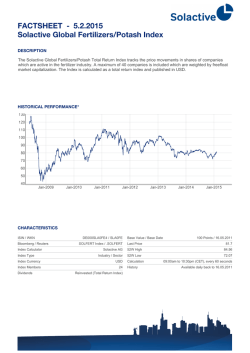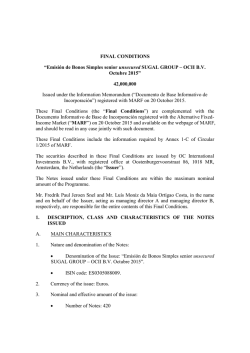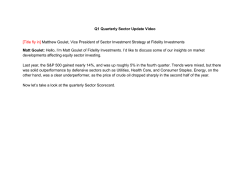
January 30, 2015 Dear Client, Market data
January 30, 2015
Dear Client,
US equity markets declined on Friday, with the S&P 500 falling 26 points, or 1.3%. Friday marked the third 1% or greater down move for the
index this week, and for the week the S&P 500 was off 2.7%. US equities started the morning weaker following a lower than expected US GDP
report, which showed the US economy grew 2.6% in the fourth quarter of 2014, versus consensus expectations calling for 3.0% percent
growth. However, the S&P 500 rallied off the morning lows to turn positive briefly in the afternoon, before a late-day sell off saw the index close
at its lows for the day. Officially, the S&P 500 Index posted its biggest monthly decline in a year. While treasury yields continued their fall, with
the US 10-year treasury rate setting fresh fifty-two week lows at 1.65%, crude oil defied the risk-off move in equities and rates, with the
international benchmark Brent crude contract rallying 8% on the day. Interestingly, stocks rallied along with crude into the 2:30 pm eastern
New York Mercantile Exchange close (floor trading closes at 2:30 pm for crude oil versus 4:00 pm for the New York Stock Exchange) however
th
fell sharply in the final ninety minutes of the trading day. Oil prices posted their 7 consecutive monthly loss and the outlook still remains bleak
in regards to demand (much bigger inventory builds this week confirmed that). OPEC continues to hold steady its position not to cut
production.
Today’s sector action was as confusing as the broader market’s back and forth throughout the day. While Energy was the only S &P 500 sector
in the green for the day, driven by the rally in crude oil, the S&P’s two worst performing sectors were Consumer Staples and Utilities, which are
thought to be defensive. The sell-off in utilities was particularly notable, given interest rates fell sharply on the day, and utilities are generally
considered to be among the most interest-rate sensitive sectors in the market. MS & Co. Chief Equity Strategist Adam Parker holds an
Underweight view on the sector, believing after a strong run in ’14 the sector appears richly valued on a number of fun damental measures.
While the market was weak today, several companies that reported results after the bell yesterday were cheered by investors, with two large
technology stocks showing meaningful gains for the day following strong earnings reports last night.
For the month of January, the S&P 500 fell 3.1%. With January showing losses for the month, many market commentators may try to
extrapolate what a weak January could mean for equity market returns over the course of the year. Over the last 55 years , the S&P 500 posted
a loss in January in 22 years. In those 22 instances, the S&P 500 went on to finish the year positive in 11 years, or half of the time. Broadly
speaking, weakness in January does not have any outsized significance on how markets perform over the rest of the year, and should not be
looked at as a prognosticator for the future direction of equity markets.
While US equities were clearly the place to be in ’14 (and much of the last six years), as the S&P 500 demonstrated exemplary performance,
with the US outperforming the MSCI World ex-US Index by 17 percentage points last year alone, we think that the tide has shifted, and
investors should favor international developed markets going forward. With earnings season making clear the headwinds US companies are
facing from a stronger US dollar, we have seen international markets already start to outperform in the first month of 2015. While US equity
markets were weak in January, foreign markets paint a different picture. In local currency terms, Europe (Euro Stoxx 50) was up 7.2% in
January, and Japan (TOPIX) was up 0.5%. In emerging markets, India (SENSEX) was up 6.5% and China (MSCI China) was up 2.8%. The
Global Investment Committee (“GIC”) continues to advocate adding to European and Japanese exposure, given that equity markets in both
countries trade at a discount to the US while also offering earnings growth that is expected to be higher than the US over th e next twelve
months. However, the GIC does expect currency volatility to continue, and would recommend splitting exposure to these countries 50 / 50
between currency-hedged and non-currency-hedged products.
In January, the S&P 500 saw eight days record closing 1% moves. This compares to just five in January 2014. We expect volatil ity to remain
elevated in 2015. Given today’s market move, you may find interesting the whitepaper published by Morgan Stanley Wealth Manag ement late
last year, Volatility… It’s Back! In the paper, Lisa Shalett, Head of Investment and Portfolio Strategies for Morgan Stanley Wealth Management,
and team discuss their view that volatility is likely to normalize going forward following five years of relatively low volat ility across major asset
classes. As a result, they believe investors should focus on risk management next year. For a copy of the whitepaper, please contact your
Financial Advisor.
As a reminder, MS & Co. chief US equity strategist, Adam Parker, has a year-end 2015 price target of 2,275 for the S&P 500. This represents
14% potential upside from today’s close. Beyond the S&P 500, Adam believes small-caps are set to outperform this year following
underperformance in ‘14. Adam remains bullish on equities for the third straight year, based on his view that earnings will grow 7% annually
over the next two years, and that markets can see modest further multiple expansion from here, with the S&P 500 approaching 17x forward
estimated earnings in his base-case.
Market data provided by Bloomberg.
Disclosures
Morgan Stanley Wealth Management is the trade name of Morgan Stanley Smith Barney LLC, a registered broker-dealer in the United States. This material has
been prepared for informational purposes only and is not an offer to buy or sell or a solicitation of any offer to buy or sell any security or other financial instrument
or to participate in any trading strategy. Past performance is not necessarily a guide to future performance.
The material has been prepared for informational purposes only and is not an offer or recommendation to buy, hold or sell o r a solicitation of an offer to buy or
sell any security, sector or other financial instrument, or to participate in any trading strategy. It has been prepared without regard to the individual financial
circumstances and objectives of individual investors. The appropriateness of a particular investment or strategy will depend on an investor's individual
circumstances and objectives.
This material is based on public information as of the specified date, and may be stale thereafter. We have no obligation to tell you when information herein may
change. We and our third-party data providers make no representation or warranty with respect to the accuracy or completeness of this material. Past
performance is no guarantee of future results.
This material should not be viewed as advice or recommendations with respect to asset allocation or any particular investment. This information is not intended
to, and should not, form a primary basis for any investment decisions that you may make. Morgan Stanley Wealth Manageme nt is not acting as a fiduciary under
either the Employee Retirement Income Security Act of 1974, as amended ("ERISA") or under section 4975 of the Internal Revenue Code of 1986 as amended
("Code") in providing this material.
Morgan Stanley Smith Barney LLC, its affiliates and Morgan Stanley Financial Advisors do not provide legal or tax advice. Each client should always
consult his/her personal tax and/or legal advisor for information concerning his/her individual situation and to learn about any potential tax or other
implications that may result from acting on a particular recommendation.
International investing entails greater risk, as well as greater potential rewards compared to U.S. investing. These risks include political and economic
uncertainties of foreign countries as well as the risk of currency fluctuations. These risks are magnified in countries with emerging markets, since these countries
may have relatively unstable governments and less established markets and economies.
Investing in commodities entails significant risks. Commodity prices may be affected by a variety of factors at any time, including but not limited to , (i) changes
in supply and demand relationships, (ii) governmental programs and policies, (iii) national and international political and economic events, war and terrorist
events, (iv) changes in interest and exchange rates, (v) trading activities in commodities and related contracts, (vi) pestilence, technological change and weather,
and (vii) the price volatility of a commodity. In addition, the commodities markets are subject to temporary distortions or other disruptions due to various factors,
including lack of liquidity, participation of speculators and government intervention.
Bonds are subject to interest rate risk. When interest rates rise, bond prices fall; generally the longer a bond's maturity, the mo re sensitive it is to this risk. Bonds
may also be subject to call risk, which is the risk that the issuer will redeem the debt at its option, fully or partially, before the scheduled maturity date. The
market value of debt instruments may fluctuate, and proceeds from sales prior to maturity may be more or less than the amount originally invested or the
maturity value due to changes in market conditions or changes in the credit quality of the issuer. Bonds are subject to the credit risk of the issuer. This is the risk
that the issuer might be unable to make interest and/or principal payments on a timely basis. Bonds are also subject to reinvestment risk, which is the risk that
principal and/or interest payments from a given investment may be reinvested at a lower interest rate.
Equity securities may fluctuate in response to news on companies, industries, market conditions and general economic environment.
Investing in foreign markets especially emerging markets entails greater risks than those normally associated with domestic markets, such as political,
currency, economic and market risks. Investing in currency involves additional special risks such as credit, interest rate fluctuations, derivative investment risk,
and domestic and foreign inflation rates, which can be volatile and may be less liquid than other securities and more sensitive to the effect of varied economic
conditions. In addition, international investing entails greater risk, as well as greater potential rewards compared to U.S. investing. These risks include political
and economic uncertainties of foreign countries as well as the risk of currency fluctuations. These risks are magnified in countries with emerging markets, since
these countries may have relatively unstable governments and less established markets and economies.
Because of their narrow focus, sector investments tend to be more volatile than investments that diversify across many sectors and companies.
Asset allocation and diversification do not assure a profit or protect against loss in declining financial markets.
Rebalancing does not protect against a loss in declining financial markets. There may be a potential tax implication with a rebalancing strategy. Investors
should consult with their tax advisor before implementing such a strategy.
The indices are unmanaged. An investor cannot invest directly in an index. They are shown for illustrative purposes only and do not represent the performance
of any specific investment.
This material is disseminated in the United States of America by Morgan Stanley Smith Barney LLC.
This material, or any portion thereof, may not be reprinted, sold or redistributed without the written consent of Morgan Stanley S mith Barney LLC.
© 2015 Morgan Stanley Smith Barney LLC. Member SIPC.
© Copyright 2025
